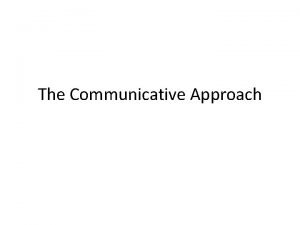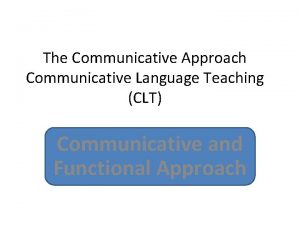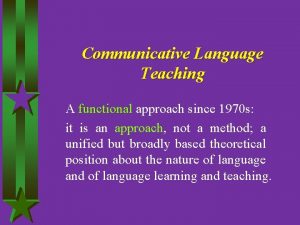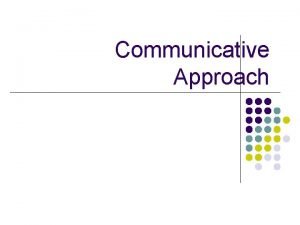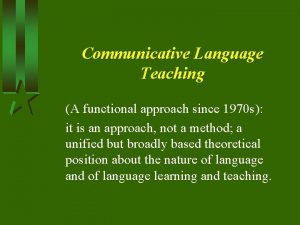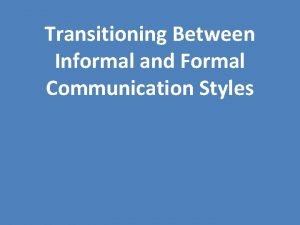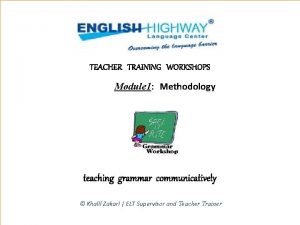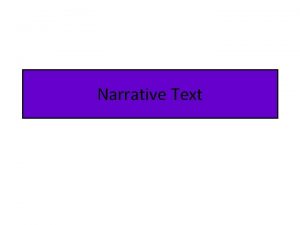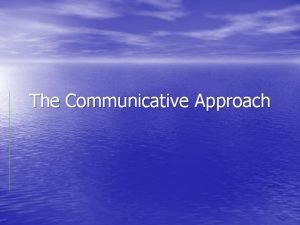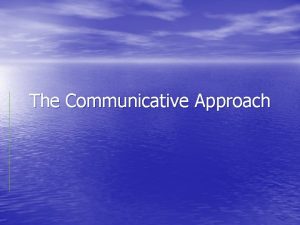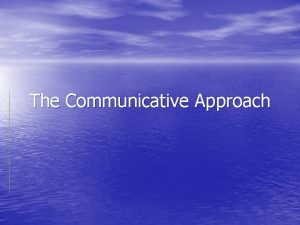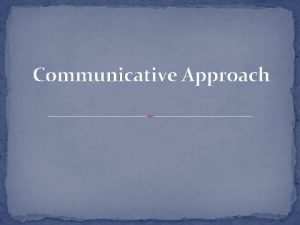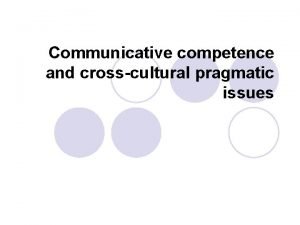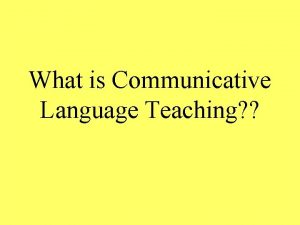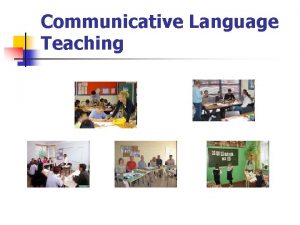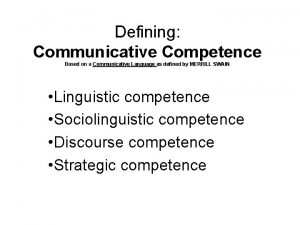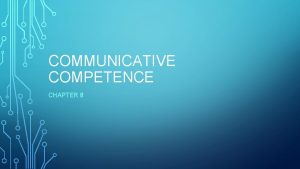The Communicative Approach CA Introduction Adherents of the

















- Slides: 17

The Communicative Approach (CA)

Introduction • Adherents of the CA acknowledge that structures and vocabulary are essential. • Structures and vocabulary are not enough for preparing Ss to communicate in the TL. • Language is used to achieve a function. • Knowledge is to negotiate meaning. • The class in this experience is conducted for immigrants to the US. who have highintermediate level of English proficiency.

Experience • Ss are greeted by the teacher and given a handout ( a copy of a sports column from a recent newspaper about who will win the world cup). • Ss are asked to read it and underline the writer’ predictions. • The TL is used all the time. • Then Ss read what they underlined. • The teacher wrote the predictions on the bb. • They all discussed the predictions.

• Ss’ paraphrases were evaluated. • On the other side of the handout, sentences included in the original text were given in a disordered manner; Ss were asked to rearrange them. • A word game was played. • Another game (pictures telling a story) was played. • A role-play was performed. • The teacher offered advice and help. • A homework was assigned.

Principles 1. Authentic language should be used. 2. Being able to figure out the speaker’s or writer’s intentions is an indication of being communicatively competent. 3. The TL is used all class time. 4. A variety of language forms should be presented and used. 5. Ss should learn about binding sentences together.

6. Language games are important for developing Ss’ communicative competence. 7. Ss should be given a chance to express their ideas and opinions. 8. Ss’ errors are tolerated and seen as a natural phenomenon. 9. Ss’ success is determined by fluency rather than accuracy.

10. The teacher has to provide Ss with communicative situations. 11. Communicative interaction encourages cooperative relations among Ss. 12. Social contexts are important to give meaning to utterances. 13. Learning to use language forms properly is an important phase of CC.

14. The teacher is an advisor. 15. In communication, alternative forms should be used. 16. Vocabulary and grammar are learned from situational context and function. 17. Ss should be given chances to develop their strategies for interpreting language as it is used by native speakers.

Reviewing the Principles 1. What is the goal of teachers who use the CA? - To help Ss become communicatively competent. - To use the TL appropriately to a given social context. - To offer knowledge of the forms, meanings and functions.

2. What is the role of the teacher? What is the role of the Ss? - The teacher is a facilitator. - S/he is the manager of the class activities. S/he is an advisor. - S/he is a co-communicator. - Ss are communicators. - They negotiate meaning. - They communicate by communicating. - Ss are managers of their LL.

3. What are some characteristics of the teaching/learning process? - Everything is performed with a communicative intent. - Ss use the TL a great deal through games, roleplays, and problem-solving tasks…. . . - Communicative activities have three features: information gap, choice, and feedback. - True communication is purposeful.

- Using authentic materials. - Working in small groups. 4. What is the nature of studentteacher interaction? What is the nature of student-student interaction? - The is an initiator and sometimes a cocommunicator. - Ss interact a great deal with one another.

5. How are the Ss’ feelings? - Ss are highly motivated to learn a FL. - Ss are free to express their individuality. - They are more secure. 6. How language is viewed? How culture is viewed? - Language is for communication. - Linguistic competence is one part of the communicative competence (CC). Knowledge of language functions is another part of the CC.

- Culture is the lifestyle of the TL natives. 7. What language areas and skills are emphasized? - Language functions are stressed over forms. - Ss work with language at the discourse level. - The four language skills are emphasized from the beginning.

8. What is the role of L 1? - L 1 has no particular role in the CA. - L 2 is the vehicle of communication. 9. How is evaluation accomplished? - A teacher evaluates both Ss’ accuracy & fluency. - A communicative can be used. - Letter writing

10. How does the teacher respond to student errors? - Errors of form are tolerated. - Errors are a natural outcome of communication.

Techniques & Materials 1. Authentic materials (e. g. genuine newspaper articles, a radio program, TV broadcast, menus, timetables…. . ) 2. Scrambled sentences 3. Language games 4. Picture strip story 5. Role-play
 Universalizing religion
Universalizing religion What is the communicative approach
What is the communicative approach Jack richards communicative language teaching today
Jack richards communicative language teaching today Functional communicative approach
Functional communicative approach Goals of clt
Goals of clt Communicative language teaching
Communicative language teaching Difference between datagram and virtual circuit approach
Difference between datagram and virtual circuit approach Theoretical models of counseling
Theoretical models of counseling Waterfall and sprinkler strategy
Waterfall and sprinkler strategy Multiple approach avoidance conflict
Multiple approach avoidance conflict Bandura's reciprocal determinism
Bandura's reciprocal determinism What is research approach definition
What is research approach definition Traditional approach to systems implementation
Traditional approach to systems implementation Deep learning approach and surface learning approach
Deep learning approach and surface learning approach Formal and informal communication examples
Formal and informal communication examples Communicative grammar
Communicative grammar Communicative achievement cefr
Communicative achievement cefr Purpose of a narrative essay
Purpose of a narrative essay

